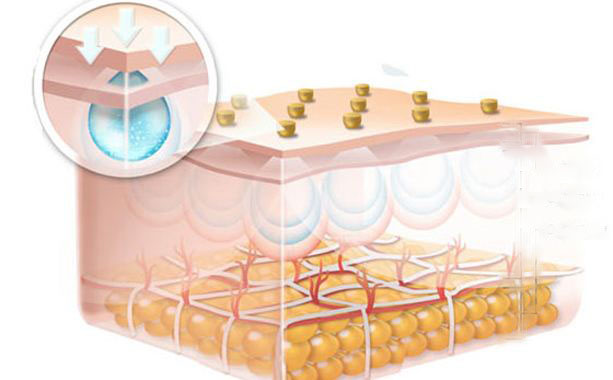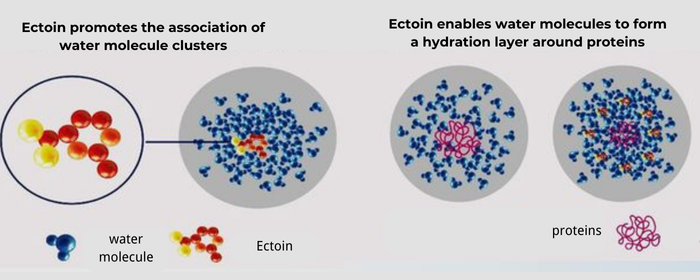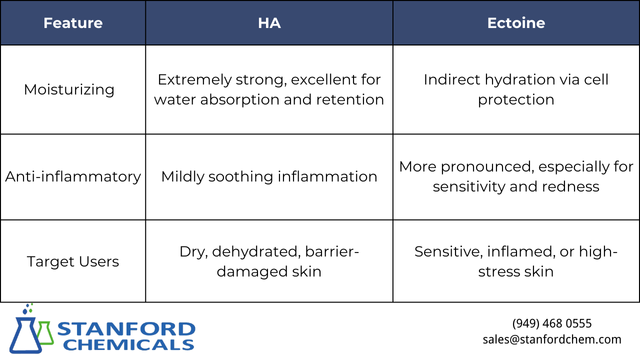Sodium Hyaluronate vs Ectoine: Which is Better for Skin and Eyes
Understanding Sodium Hyaluronate and Ectoine
As a key moisturizing ingredient, sodium hyaluronate is widely recognized. Let’s begin with a brief introduction.
Sodium hyaluronate (the sodium salt form of hyaluronic acid) is a polysaccharide naturally present in human tissues. It is a transparent, viscous substance with excellent moisturizing, lubricating, and anti-inflammatory properties. It is a common ingredient in skincare products and an effective component in eye drops for relieving dry eyes.
So, what is ectoine?
Ectoine is an amino acid derivative found in “Halophile” that thrives in extreme environments. In 1985, German scientist Professor Galinski discovered ectoine in the saline lakes of the Egyptian desert.
It regulates cell osmotic pressure, acting as a natural “protective shield” that enables halophilic bacteria to survive in extreme conditions like high temperatures, high salinity, and intense UV radiation. Biotech companies identified its potential and began producing ectoine (C₆H₁₀N₂O₂) through fermentation. Today, ectoine is used in biomedicine (eye drops, nasal sprays, oral sprays) and skincare products.
Fig 1. Desert salt lake with no grass growing
Sodium Hyaluronate vs Ectoine: Which is Better for Skin
Sodium hyaluronate has been used in skincare products since the 1980s. The exceptional moisturizing ability has made it a star ingredient in the skincare industry. Ectoine, widely adopted by skincare brands since 2019, has gained recognition for its outstanding moisturizing and repair effects, leading to rapid growth in its applications.
Let’s compare the effects of the two
1. Moisturizing
Both ingredients provide moisturizing benefits, but their mechanisms and results differ.
Sodium hyaluronate molecules can absorb hundreds to thousands of times their weight in water. It draws moisture from the environment and locks it in, keeping the skin hydrated. It also forms a breathable hydrating film on the skin’s surface, reducing water evaporation and preventing dryness. What’s more, low-molecular-weight HA can penetrate the dermis, offering deep hydration.
Fig 2. HA for skin
Ectoine’s moisturizing function differs, focusing more on protection and regulation. It binds with water molecules to form a stable hydration shell around cells, creating a protective shield. This shield effectively prevents water loss from skin cells and maintains water balance inside and outside the cells. Additionally, by stabilizing cell membranes and protein structures, ectoine enhances cellular resistance to external stressors like dryness, UV rays, and high temperatures, reducing water loss risks.
Fig 3. The moisturizing principle of Ecdoin
Conclusion: Ectoine’s moisturizing ability leans toward “protective hydration,” without directly absorbing water like sodium hyaluronate. For those focused on hydration, sodium hyaluronate offers more immediate results.
2. Skin Repair:
Sodium hyaluronate is popular in skincare for its skin repair properties. It stabilizes and attracts growth factors (EGF), accelerating cell proliferation, tissue regeneration, and wound healing. It also has anti-inflammatory and soothing effects, reducing damage caused by inflammation.
Ectoine’s repair function is more prominent, especially for sensitive and inflamed skin. When exposed to environmental stressors like high temperatures, UV radiation, hypoxia, heavy metal toxicity, or viral infections, ectoine triggers emergency protective and regenerative responses, helping cells maintain normal physiological activity. Merck data shows that 1.0% Ecdoin can induce a faster stress response, prevent cell damage, and increase the speed of self-healing by 2-3 times.
Conclusion: For skin sensitivity, barrier damage, acne-related breakouts, or sunburn-induced redness, products with ectoine can quickly provide repair and soothing effects.
Key Characteristics Comparison:
Sodium Hyaluronate vs Ectoine: Which is Better for Eyes
Sodium hyaluronate and ectoine are both vital ingredients in eye drops, but their benefits differ in focus.
Sodium hyaluronate is more suitable for individuals with dry eye syndrome, contact lens wearers, or those needing immediate hydration. Its properties allow it to absorb water and form a hydrating film on the eye surface, relieving dryness. Moreover, its natural presence in human tissues ensures high safety with minimal irritation.
Ectoine, on the other hand, is ideal for individuals with eye inflammation, sensitivity, or exposure to harsh environments. By forming a “hydration shell,” ectoine enhances the stability of ocular cells, protecting them from external irritants. It also stabilizes the lipid layer of the tear film, preventing excessive evaporation.
–Synergistic Effects of Sodium Hyaluronate and Ectoine
Studies show that combining ectoine with sodium hyaluronate delivers enhanced synergy in relieving dry eyes. This combination significantly improves water-binding ability, effectively hydrates the eyes, stabilizes the tear film, and reduces tear evaporation. Additionally, it forms a durable hydrating film on the eye surface, firmly adhering to the cornea and ocular surface to provide robust protection against external irritants. Furthermore, this combination is highly effective in alleviating irritation caused by environmental dryness, inflammation symptoms, and itching or burning sensations during allergic reactions.
Stanford Chemical Company (SCC) is an excellent supplier of sodium hyaluronate powder and ectoine powder. In addition, we also provide chondroitin sulfate for cataract surgery eye drops and joints. For more information on these materials, please check out our home page.




